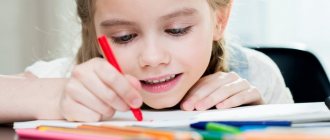The general activity of the nervous system, its balance, increased sensitivity of nervous structures, a special predisposition to perceive sounds, a palette of colors, spatial forms, to establish cause-and-effect relationships and relationships, to synthesis and analysis, etc. can be considered as special inclinations.
However, the possession of certain inclinations does not guarantee a person their development into the corresponding abilities. In addition, the lack of necessary inclinations for the development of some abilities (their deficit) can be compensated for by stronger development of other inclinations. It is especially important that the development of certain inclinations is a socially determined process associated with the conditions of upbringing and the peculiarities of the development of society.
Typology of abilities
The main division of abilities in psychology includes general and special abilities. General abilities determine a person’s success in a wide variety of activities. These include mental abilities, developed memory, perfect speech, subtlety and accuracy of hand movements, and the ability to establish and maintain contacts with other people. Special abilities are built on the inclinations of a special kind and their development; they determine the success of an individual in specific types of activity (music, mathematics, linguistics, technology, etc.).
Based on another classification, abilities are divided into actual and potential.
Potential abilities are not realized in a specific type of activity; they can be updated when existing social conditions change. Actual, that is, realized, abilities include not only those that are used and developed in certain types of activities, but also those that are necessary at the moment and are used in the present.
Another division of abilities into several groups is proposed, depending on whether they are characteristic of all people or only of individual individuals.
The first group consists of elementary general abilities, inherent to varying degrees in all people. They are expressed in the main forms of mental reflection of the surrounding world, including: the ability to sense and perceive, remember and experience, think and make simple decisions, etc.
The second group is represented by elementary private abilities inherent in individuals and which are more complex personality traits. These include: eye, ear for music, critical thinking, kindness, perseverance, etc.
The third group includes complex general abilities that are inherent to a certain extent in all people. They are manifested in abilities for universal human mass activities, such as work, learning, play, communication with each other, moral attitude towards others, aesthetic perception of the surrounding objective reality.
The fourth group is associated with complex abilities for certain types of activities. For example, to such professions as: doctor, sculptor, ballerina, etc.
The problem of describing abilities is of particular importance in connection with career guidance and choice of profession. A forecast about suitability for a particular activity should be based on the provisions on the development of abilities in the activity.
Abilities as a personality property. Inclinations and abilities
Previous20NextAbilities are the properties and qualities (individual characteristics) of a person that make him suitable for successfully performing any type of socially useful activity (S.L. Rubinstein).
In studies, work, and creativity, people differ noticeably from each other in the pace of progress, the significance and originality of the results achieved. When manifestations of this kind appear with an equal supply of knowledge, skills and abilities and the same attitude towards activity, they indicate such features of the human psyche that are called abilities.
When we talk about abilities, we mean a person’s capabilities in a particular area. The basis for talking about the presence of abilities in a person are two indicators: 1) speed of mastery of an activity (a person quickly and successfully masters an activity, easily acquires the relevant knowledge, abilities and skills. It must be remembered that abilities are not reduced to knowledge, abilities and skills, but ensure their rapid acquisition, fixation and effective practical application); 2) quality of achievements (a person’s achievements significantly exceed the average level).
Why, other things being equal, do some people master activities faster and more easily and achieve greater success than others? The fact is that each activity (pedagogical, musical, design, literary, etc.) makes certain demands on the work of a person’s analyzers, the speed of his reactions, and personality traits. Some people have the necessary qualities required by a particular activity, others do not. If a person has individual psychological characteristics that best meet the requirements of the corresponding activity, then this means that they are capable of it.
Abilities are the psychological characteristics of a person that ensure success in activity and communication and the ease of mastering it. Let us pay attention to the most important aspects of this definition. This:
• individual characteristics, i.e. that which distinguishes one person from another;
• not physiological (tall, long fingers, etc.), but psychological characteristics;
• not any individual psychological characteristics, but only those that correspond to the requirements of a certain activity, because there is no concept of abilities abstracted from the type of activity.
Teplov B.M. identified 3 main signs of abilities:
1) these are individual psychological characteristics;
2) determining the success of the activity;
3) not reducible to knowledge, skills, abilities, but also determining the speed of learning new ways and techniques of activity.
Consequently, abilities must always be assessed in connection with the activity, the process of mastering it and the results achieved.
Any activity requires from a person not one separate ability, but a whole series of interrelated abilities. For example, literary activity includes, in addition to an aesthetic position, also impressionability, observation, creative imagination, figurative memory, and the ability for precise and expressive language.
The weak development of any one ability can be compensated for by the enhanced development of others. This provides ample opportunities for mastering various types of activities and choosing a profession.
The lack of private ability can also be compensated by hard work, perseverance, and effort.
Types and levels of abilities. There are several approaches to classifying abilities. Types of abilities according to their focus, or specialization, can be divided into general and special, theoretical and practical, educational, interpersonal and subject-related activity (Fig. 3.11). The most common is the division of abilities into general and special. In the proposed figure, natural (biologically determined) abilities are understood as their inclinations
(see below). General abilities are a prerequisite for the comprehensive development of the individual.
Rice. 3.11. Classification of abilities
General abilities are understood as a system of individual psychological characteristics of a person, which explains the relative ease and productivity in mastering and carrying out various types of activities and communication. These are mental activity, a high level of analytical and synthetic activity, concentration, developed memory and speech, accuracy and subtlety of hand movements, high learning ability, efficiency, etc. In foreign psychology, these abilities are referred to as intelligens, which is equivalent to the expression “mental abilities” .
Special abilities are understood as a system of individual psychological characteristics of a person, which determines a person’s success in special types of activity and communication, where a special kind of inclinations and their development are necessary. These are linguistic, mathematical, technical, literary, stage, sports, musical, etc. abilities.
Theoretical abilities determine a person’s propensity for abstract logical thinking (theoretical scientists, philosophers), while practical abilities underlie the propensity for concrete practical actions.
Learning abilities influence the success of pedagogical influences, the formation of personality traits, and the acquisition of knowledge, skills and abilities.
Interpersonal abilities are the abilities to communicate and interact with people, and subject-related abilities are associated with the interaction of people with nature, technology, sign systems, artistic images, etc.
The structure of an individual’s abilities depends on the level of its development. According to the productivity of activity, reproductive and creative levels of abilities are distinguished; the reproductive level is associated with a high ability to assimilate already known ways of performing an activity, acquiring knowledge, abilities, skills, mastering established patterns of activity and communication; the creative level is associated with the creation of a new, original product, finding new ways of performing an activity . It is obvious that both levels are closely interrelated: the reproductive level includes elements of the creative one, and vice versa.
According to the level (degree) of perfection of abilities, capable, gifted, talented and brilliant people are distinguished (Fig. 3.12).
A capable person has favorable opportunities for the development of mental characteristics that are equally important for many types of activity. Gifted is a person who, from birth, has many inclinations to develop a wide variety of abilities. Giftedness is a set of general and special abilities characteristic of a particular person. A gifted person stands out in a certain area among other people performing activities under the same conditions.
Rice. 3.12. Levels of ability development
Giftedness is a multifaceted concept. It can be considered as:
1) a qualitatively unique combination of abilities that ensures the success of the activity;
2) general abilities that determine the breadth of a person’s capabilities, the level, as well as the originality of his activities;
3) a person’s mental potential, his intelligence;
4) a set of inclinations, prerequisites for abilities.
Currently, giftedness is increasingly being defined as “the ability for outstanding achievements in any socially significant area of human activity” (N.S. Leites).
A gifted person is not necessarily talented. Talent is the highest level of development of abilities. Talented people are considered to be people who have a high degree of talent realized in a certain area of human activity, those who have already achieved significant success in activity and communication.
A high level of development of any individual ability does not constitute talent: thus, a vivid imagination without the harmonious development of other aspects of the artist’s talent will not bring the desired success. It is no coincidence that they say: “Imagination is like fire: a good servant, but a bad master.”
Domestic psychologists (B.M. Teplov, N.S. Leites, V.A. Krutetsky, etc.) identified some common features characteristic of talent:
1) attentiveness, composure, readiness for hard work;
2) the need for labor and pronounced diligence;
3) speed of thought processes, systematicity of mind, high level of analysis and generalization, high productivity of mental activity.
Talent, or skill, is not only qualified knowledge, skills and abilities, the main thing for a talented person is psychological readiness to search for and make creative decisions, as well as a deeply emotional, inspired attitude to activity, to the chosen profession.
The highest manifestation of talent is genius. A person who, thanks to his abilities, has achieved outstanding and recognized success in various aspects of human activity is called a genius. The ideas, concepts, and results of the work of geniuses are ahead of their time and open new horizons for humanity. There are quite a lot of talented people, but only a few geniuses (Leonardo da Vinci, M.V. Lomonosov, A.S. Pushkin). Talent, and even more so genius, is the greatest social value, a universal property.
Natural and acquired abilities. There are various theories explaining the origin of abilities. The theory of hereditary abilities proclaims the heredity of abilities and reduces them to inclinations. The theory of acquired abilities, on the contrary, completely ignores the natural prerequisites of abilities and considers them conditioned by environment and upbringing. None of these theories correspond to reality. In the first case, the determination of abilities is reduced only to internal ones, in the second - only to external conditions, while in the formation of abilities (as well as mental health in general), external causes act indirectly through internal ones.
In Russian psychology, the problem of natural prerequisites for abilities has been convincingly revealed. It has been established that abilities are lifetime formations; their development, under certain conditions, occurs throughout life, and the environment and upbringing actively shape them.
B.M. Teplov showed that the prerequisites for the development of abilities are the anatomical, physiological and functional characteristics of a person, called inclinations. These include:
1) some anatomical and physiological characteristics of the body - height, weight, physique, health status, etc.;
2) brain structure;
3) structure of sense organs (absolute pitch);
4) typological features of the nervous system (strength, balance, mobility, reaction force, pace of work);
5) a certain ratio in the work of the right and left hemispheres of the brain;
6) the ratio of the first and second signaling systems;
7) gene pool (features of gene structure), etc.
Inclinations should not be identified with heredity, since they are also a product of intrauterine development. In other words, inclinations are the capabilities with which a person is born. Without appropriate inclinations, the development of abilities is impossible, but the presence of inclinations is not always a guarantee that a person will demonstrate abilities. Inclinations are not ready-made abilities, but only an innate predisposition to their development, which can only manifest themselves under appropriate conditions; these are only possible future abilities.
Inclinations contain opportunities for the development of abilities in the process of training, education and work, but they do not contain abilities and do not guarantee their development; this is only one of the conditions for the formation of abilities.
Thus, the inclinations should be understood as the primary, natural basis of the ability, not yet developed, but making itself felt during the first attempts at activity.
Inclinations are non-specific in relation to specific content and specific forms of activity; they are polysemantic. This means that on the basis of the same inclination, under appropriate conditions, different abilities can be developed. For example, with an absolute ear for music, a person can become a tuner of musical instruments, a composer, a conductor, etc. Based on such inclinations as speed, subtlety and dexterity of movements, the abilities of a gymnast, violinist, surgeon, and also a pickpocket can be developed.
In the presence of favorable inclinations and under optimal conditions of life and activity, abilities can begin to form very early and develop very quickly, which sometimes creates the illusion of their innateness. So, V.A. Mozart began composing music at the age of 3–4, A.S. At the same age, Pushkin composed his first poetic work, K.P. Bryullov entered the Academy of Arts at the age of 9, and the Moscow schoolgirl Nadya Rusheva, practically a genius in the visual arts, had created 10 thousand original drawings by the age of 17 (she died in 1969).
However, a lack of early achievement does not always indicate a lack of ability. Such famous people as L. Pasteur, C. Linnaeus, W. Scott, I.A. Goncharov, V.Ya. Shishkov and many others showed themselves at a relatively late age. For example, S.A. Aksakov wrote his first book at the age of 56, and his best works – “Family Chronicle” and “Childhood Years of Bagrov the Grandson” – at the age of 65–67.
Not a single person, no matter how excellent his inclinations he may possess, will be able to become an outstanding musician, actor, athlete, scientist, if he does not engage in relevant activities a lot and persistently. Conversely, even in the absence of good inclinations, a hardworking and persistent person with strong and stable interests and inclinations for any activity can achieve noticeable success. In your future activities, it is also important to have certain abilities; you can learn more about this in section 6 of this manual.
Personality orientation
To get to know a person, it is very important to understand what he has done in his life as a member of society. But it is even more important to understand what he is striving for and in the name of what, in his opinion, he has not yet managed to achieve and how to achieve his goal. All this determines the orientation of the personality, i.e., its interests and inclinations, ideals, worldview and beliefs, which are at the same time the motives of activity. All these types of orientation always contain needs, attitudes and relationships in their structure.
Previous20Next
Giftedness
For a long time, giftedness has been synonymous with ability. However, S. L. Rubinstein argued that giftedness is characterized by a set of personality traits. There is the following definition: giftedness is a combination of a number of abilities that ensure the success (level and originality) of performing a certain activity.
Research on gifted children conducted by N. S. Leites allowed the scientist to identify some particularly important abilities that form the structure of intellectual giftedness:
- high concentration, concentration, composure;
- readiness for long and hard work, which develops into a peculiar inclination to work;
- some features of thinking (speed of thought processes, developed skills of analysis and synthesis, flexibility of mind, tendency to systematize, etc.).
However, the manifestation of abilities is always strictly individual and unique, therefore it seems almost impossible to reduce the talent of people engaged in the same activity to a set of specific indicators.
Classification of abilities
The classification structure of abilities can be described as follows:
- In accordance with origin: natural abilities have a biological structure and are determined by the development of innate inclinations;
- social abilities - those that were acquired in the process of upbringing and training.
- general abilities are necessary due to the fact that they have a wide scope of application;
- potential abilities manifest themselves over time after exposure to certain conditions;
- giftedness;
Conditions for the formation of abilities
The foundation for the emergence and development of abilities are the neuromuscular functional organs, which are formed in a child from birth to 6 years. In a healthy child, all physiological elements (hearing, speech, nervous system, thinking) allow the full development of both basic and special abilities.
When teaching children, an important condition for the effective development of abilities is their comprehensive development. Some abilities are closely related to others (speech is related to hearing, vision is related to thinking). The development of just one ability in isolation from others is unacceptable.
For the comprehensive development of a child it is necessary:
- provide a creative approach to learning;
- create interest in the subject of study;
- create a positive emotional mood;
- provide the necessary degree of complexity of tasks in relation to the abilities being mastered.
A creative approach to business forms independent thinking in a child, as a result of which he can:
- find new solutions to assigned problems;
- analyze your actions;
- adjust them, improving your capabilities.
During training, it is necessary to ensure that the tasks assigned to the child are sufficiently difficult. They should not be too complex: if they are unfulfilled, this may hinder the development of appropriate abilities.
If the tasks and the activities corresponding to them are too simple, then this will also not lead to the proper development of abilities, but will only ensure their functioning at the current level.
In the process of activities that develop the child’s abilities, his emotional mood plays a significant role in the development of new skills and abilities.
When certain positive results are achieved in a child’s activities aimed at developing his specific abilities, it is necessary to take care of the emotional reinforcement of each of his successes, since failures also arise in the process of activity, which, against the backdrop of successes, should not cause a negative attitude of the child towards the activity he is performing.
Inclinations are the natural basis of abilities
Abilities are, in psychology, personality traits that determine the speed and quality of mastering knowledge, skills and abilities. The initial form of future abilities are inclinations, which are hereditary anatomical and physiological characteristics of the body, which can manifest themselves in the form of the following properties of the nervous system:
- Special perception of artistic forms, sounds or colors (the ability to recognize or analyze them, quickly memorize or reproduce them).
- High sensitivity of the nervous system.
- The pursuit of knowledge, high activity in public relations.
- Good memory and logical thinking, ability to analyze or generalize.
The difference between inclinations and abilities is that they are not specific and cannot specifically relate to any one activity or to any particular ability. The same inclinations can be used in the formation of different abilities in different fields of activity.
For example, excellent eyesight and innate attentiveness can become part of the abilities of an artist or professional archer. Different types of activities require certain abilities, which in turn can be based on the inclinations they require.
The makings of the visual system can be used in activities that require good vision (fine arts, sports). The inclinations of the speech apparatus can be successfully used in a field that requires a high level of its development (oratory, linguistics).
Inclinations are the basic “bricks” on which a person’s abilities and all professional activities are built. They begin to appear in preschool and early school age. During this period, the functional development of areas of the brain responsible for the coordination of the organs of movement, the logic of thinking, as well as the improvement of various analyzers occurs:
- vision;
- hearing;
- touch.
The discovered inclinations in the child must be developed in relation to the area of activity that interests him. As a result, the formation of abilities will take place more effectively and meet the necessary requirements of this activity.
Definition of the term “ability” in psychology
In psychology, abilities are properties of the human psyche, determined by the special development of functional organs and psychological structures, which allow him to master new knowledge, skills and abilities in a specific field of activity with particular speed and success.
For people who have certain abilities (in a specific field of activity), the speed of mastering new knowledge and skills is several times higher than the effectiveness of development in this area for those people who do not have such abilities.
For example, if a child has mathematical abilities (ease of arithmetic calculations, good memory, pronounced logical thinking), it is much easier for him to study mathematics and solve complex problems, unlike a child who does not have these abilities.
To successfully master and carry out different types of activities, different abilities are required. The speed and quality of acquiring new knowledge, skills and abilities in the relevant field of activity depends on them.






